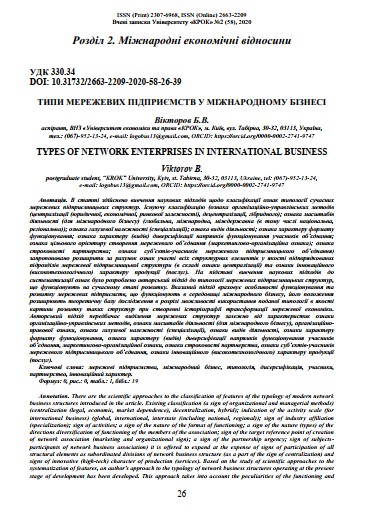TYPES OF NETWORK ENTERPRISES IN INTERNATIONAL BUSINESS
DOI:
https://doi.org/10.31732/2663-2209-2020-58-26-39Keywords:
network enterprises, international business, typology, dissertification, participants, partnership, innovative characterAbstract
There are the scientific approaches to the classification of features of the typology of modern network business structures introduced in the article. Existing classification (a sign of organizational and managerial methods) (centralization (legal, economic, market dependence), decentralization, hybrid); indication of the activity scale (for international business) (global, international, interstate (including national, regional)); sign of industry affiliation (specialization); sign of activities; a sign of the nature of the format of functioning; a sign of the nature (types) of the directions diversification of functioning of the members of the association; sign of the target reference point of creation of network association (marketing and organizational sign); a sign of the partnership urgency; sign of subjects-participants of network business association) it is offered to expand at the expense of signs of participation of all structural elements as subordinated divisions of network business structure (as a part of the sign of centralization) and signs of innovative (high-tech) character of production (services). Based on the study of scientific approaches to the systematization of features, an author's approach to the typology of network business structures operating at the present stage of development has been developed. This approach takes into account the peculiarities of the functioning and development of network enterprises operating in the international business environment, its provisions expand the theoretical basis of the study in terms of the possibility of using this typology as a picture of such structures in creating a historiography of network economy transformation. The author's approach involves the allocation of network structures depending on the characteristics of organizational and management methods, characteristics of the scale of activity (for international business), organizational and legal characteristics, characteristics of industry (specialization), characteristics of activities, characteristics of the format, types of characteristics (types) diversification of directions of functioning of members of association, marketing-organizational sign, signs of urgency of partnership, signs of subjects-participants of network business association, signs of innovative (high-tech) character of production (services).
Downloads
References
Вайлунова В. Г. Сетевые структуры и их роль в повышении конкурентоспособности предприятий. 2008. С. 53-60.
Группа компаний Актив. URL : https://aktivcorp.com/.
Іжевський П. Г. Підприємницькі мережі як умова економічної модернізації підприємств. Економіка і суспільство. 2016. Вип. 3. С. 193-197.
Інвестиційна компанія. Юридична енциклопедія: в 6-ти т. / ред. кол. Ю. С. Шемшученко (відп. ред.) та ін. Київ : Українська енциклопедія ім. М. П. Бажана, 1998. Т.2: Д-Й. 744 с.
Кавун О. О. Підприємницькі мережі у роздрібній торгівлі України: сутність, класифікація і перспективи формування. Актуальні проблеми економіки. 2010. № 5 (107). С. 97-98.
Карлина Е. П. Объединяясь в сети: две модели сетевой организации бізнес процессов. Российское предпринимательство. 2004. № 1. С. 48-51.
Квач Я. П., Коваль В. В., Циналєвська І. А. Забезпечення розвитку експорту високотехнологічних товарів в умовах зміни векторів зовнішньої торгівлі. Вісник Національного університету «Львівська політехніка». Менеджмент та підприємництво в Україні: етапи становлення і проблеми розвитку. 2015. № 819. С. 420-426.
Клочкова О. В. Роздрібні торговельні мережі: регіональні фактори розвитку : автореф. дис. … канд. екон. наук : 08.00.04. Харків, 2011. 20 с.
Коротков Г. К., Етин Д. Развитие высокотехнологичных предприятий в период глобализации мировой экономики. Вестник ИрГТУ. 2014. № 9(92). С. 212-216.
Николаев М. А., Ступаков Б. А. Сетевые организационные структуры: основные понятия, признаки, виды и роль в современной экономике. Вестник ПсковГУ. 2014. № 5. С. 3-14.
Пікуш Т. А. Організаційно-економічні аспекти розвитку торговельних мереж в Україні : автореф. дис. … канд. екон. наук : 08.07.05. К., 2006. 23 с.
Селезнева Н. А. Сущность и классификация финансовых сетей. Финансы и кредит. 2015. № 33. С. 22-30.
Сущенко О. А., Буздаков Л. М. Розвиток управління мережевими формами взаємодії бізнес-структур. Управління проектами та розвиток виробництва. 2011. № 3(39). С. 52-56.
Холдинг. Юридична енциклопедія: в 6-ти т. / ред. кол. Ю. С. Шемшученко (відп. ред.) та ін. Київ : Українська енциклопедія ім. М. П. Бажана, 2004. Т.6: Т-Я. 768 с.
Limański A. Funkcjonowanie i rozwój organizacji sieciowych. Academic Journals and Conferences. 2017. № 6. S. 92-102.
Limański A., Drabik І. Powiązania sieciowe przedsiębiorstw na rynkach zaawansowanych technologii. Nierówności Społeczne a Wzrost Gospodarczy. 2018. № 53. S. 49-60.
Miles R., Snow C., Coleman H.Organizing in the knowledge area: anticipating the cellular form. Academy of management executive. 1992. Vol. 20. № 3. Р. 7–20.
RB Rail AS. URL : http://www.railbaltica.org/lv/# .
Sаmsung. Про компанію. URL : https://www.samsung.com/ua/aboutsamsung/company/history/.


